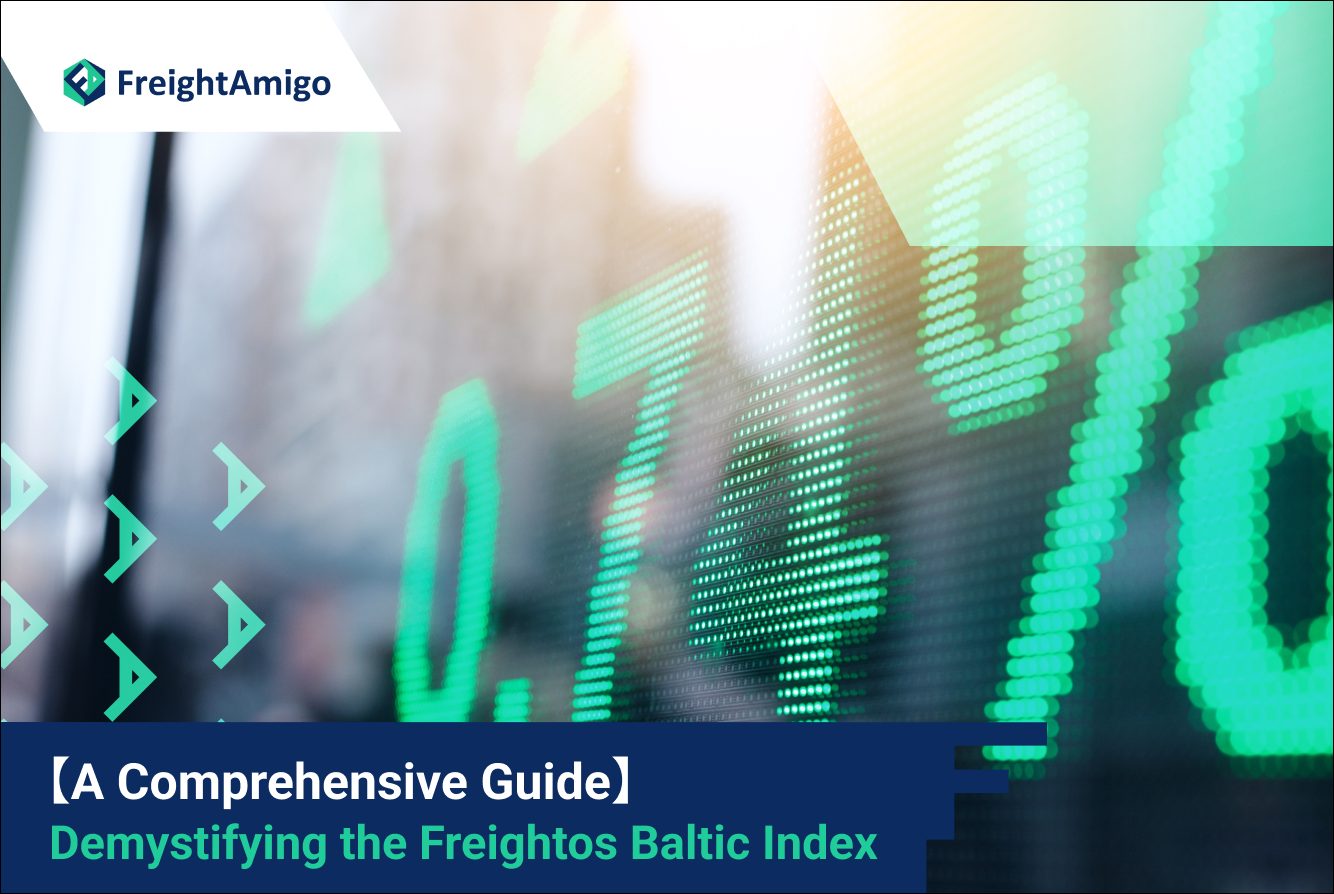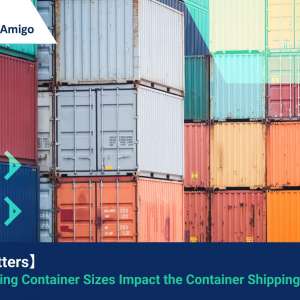Author Name: Tiffany Lee – Marketing Analyst at FreightAmigo
The world of shipping and logistics is a complex and dynamic one, with numerous factors influencing the movement of goods across the globe. In this comprehensive guide, we will delve into the Freightos Baltic Index, shedding light on its history, calculation, role, applications, and future trends. Whether you are a seasoned professional in the shipping industry or a curious mind seeking to understand the mechanisms behind global freight rates, this guide aims to demystify the Freightos Baltic Index and provide valuable insights into its significance and impact.
Want To Compare The Best Express, Air Freight, Sea Freight, Rail Freight & Trucking Rates So As To Have Better Control On Cost?
Understanding the Freightos Baltic Index
The Freightos Baltic Index is an essential tool for understanding the dynamics of the global freight market. It provides valuable data and insights into the movement of shipping rates, enabling stakeholders to make informed decisions and strategies. Established by Freightos, a leading digital freight platform, the index serves as a benchmark for freight rates, offering transparency and reliability in an industry prone to fluctuations and uncertainties.
The index covers various trade routes and shipping methods, providing a comprehensive view of the global freight market. By understanding the components and structure of the Freightos Baltic Index, industry players can gain a deeper understanding of the factors influencing freight rates and make data-driven decisions to optimize their shipping operations.
History and Significance of the Freightos Baltic Index
The history of the Freightos Baltic Index dates back to its inception in response to the need for a standardized and reliable measure of freight rates. With the increasing globalization of trade and the rising complexity of supply chains, there was a growing demand for a transparent and accurate index that could serve as a reference for market participants.
Over the years, the Freightos Baltic Index has become a trusted source of information for shippers, carriers, and industry analysts, offering insights into market trends, price fluctuations, and trade dynamics. Its significance lies in its ability to provide a common language for discussing and analyzing freight rates, fostering transparency and efficiency in the shipping industry.
How the Freightos Baltic Index is Calculated
The calculation of the Freightos Baltic Index involves a meticulous process that takes into account various factors influencing freight rates. It incorporates data from actual shipments, capturing real-time market conditions and trade dynamics. By leveraging advanced algorithms and statistical models, the index derives comprehensive insights into the movements of freight rates across different trade lanes and shipping modes.
The transparency and accuracy of the calculation process are paramount, as they directly impact the reliability and relevance of the index. By understanding the methodology behind the Freightos Baltic Index, industry stakeholders can trust the integrity of the data and make well-informed decisions based on robust market insights.
The Role of the CONTAINER INDEX in the Freightos Baltic Index
Within the Freightos Baltic Index, the CONTAINER INDEX plays a pivotal role in capturing the dynamics of container shipping rates. As containerized cargo accounts for a significant portion of global trade, the CONTAINER INDEX provides specific insights into the movements of container freight rates across key trade routes.
By analyzing the CONTAINER INDEX within the framework of the Freightos Baltic Index, industry participants can gain a deeper understanding of the factors shaping container shipping rates, including supply and demand dynamics, trade volumes, and geopolitical influences. This granular level of data empowers stakeholders to tailor their strategies and operations to the nuances of containerized shipping, optimizing their cost-effectiveness and competitiveness in the market.
Analyzing the Global Average Freight Rate Index
In addition to the CONTAINER INDEX, the Freightos Baltic Index incorporates the Global Average Freight Rate Index, offering a comprehensive view of freight rate movements across various shipping modes, including bulk and tanker shipping. This holistic approach to analyzing freight rates enables industry players to grasp the broader trends and dynamics shaping the global shipping market.
By examining the Global Average Freight Rate Index, stakeholders can identify overarching patterns, market trends, and cyclical fluctuations that impact different segments of the shipping industry. This macro-level analysis enhances the strategic decision-making process, enabling shippers, carriers, and analysts to anticipate market shifts and adapt their operations accordingly.
Using the Freightos Baltic Index for Market Insights
One of the primary benefits of the Freightos Baltic Index is its utility in providing valuable market insights to industry participants. By leveraging the index’s data and analysis, stakeholders can gain a competitive edge in understanding the prevailing market conditions, benchmarking their performance, and adapting to changing trade dynamics.
For shippers, the index serves as a valuable tool for negotiating freight contracts, evaluating shipping options, and optimizing their supply chain strategies. Carriers can utilize the index to assess market demand, adjust their pricing strategies, and identify opportunities for route optimization. Additionally, industry analysts and researchers rely on the index to conduct in-depth market studies, forecast trends, and contribute to the body of knowledge shaping the shipping industry.
Limitations and Criticisms of the Freightos Baltic Index
While the Freightos Baltic Index offers valuable insights into the global freight market, it is essential to acknowledge its limitations and address criticisms that may arise. One of the key challenges is the dynamic nature of the shipping industry, characterized by geopolitical events, regulatory changes, and unforeseen disruptions that can impact freight rates.
Critics may argue that the index’s reliance on historical data and statistical models could limit its accuracy in capturing real-time market conditions. Additionally, the index’s coverage of specific trade routes and shipping modes may not fully encapsulate the complexities of the entire global shipping landscape. However, it is essential to recognize that the index continuously evolves to address these challenges, leveraging advanced data analytics and expanding its coverage to enhance its relevance and reliability.
Future Trends and Developments in the Freightos Baltic Index
As the shipping industry continues to evolve and embrace digital transformation, the future of the Freightos Baltic Index holds promising developments and advancements. With the integration of innovative technologies, such as artificial intelligence and blockchain, the index is poised to enhance its data accuracy, transparency, and real-time insights, providing industry stakeholders with a more robust tool for navigating the complexities of the global freight market.
Moreover, the expansion of the index’s coverage to include emerging trade routes, alternative shipping methods, and sustainable transport initiatives reflects the evolving nature of global trade. By staying ahead of market trends and embracing technological innovations, the Freightos Baltic Index is positioned to remain a prominent and indispensable resource for industry professionals seeking to navigate the dynamic landscape of international shipping.
Applications of the Freightos Baltic Index in the Shipping Industry
The applications of the Freightos Baltic Index extend across various facets of the shipping industry, offering valuable benefits to shippers, carriers, freight forwarders, and other stakeholders. From strategic decision-making to operational optimization, the index serves as a versatile tool that informs and empowers industry participants in their day-to-day activities and long-term planning.
Shippers can leverage the index to benchmark their freight costs, negotiate contracts with carriers, and optimize their shipping routes based on market insights. Carriers, on the other hand, can use the index to adjust their pricing strategies, identify demand patterns, and enhance their market competitiveness. Additionally, freight forwarders and logistics providers rely on the index to offer informed guidance to their clients, navigate market uncertainties, and streamline their service offerings.
Conclusion
In conclusion, the Freightos Baltic Index stands as a cornerstone of transparency and insight in the global shipping industry. Its comprehensive coverage, meticulous calculation, and valuable market insights make it an indispensable tool for stakeholders seeking to navigate the complexities of the international freight market. As the index continues to evolve and adapt to the changing dynamics of global trade, its role in shaping strategic decisions, optimizing operations, and fostering transparency will remain essential.
For industry professionals and organizations, embracing the Freightos Baltic Index as a trusted resource for market intelligence and strategic planning can lead to enhanced competitiveness, improved cost-effectiveness, and a deeper understanding of the intricate web of global trade. By demystifying the Freightos Baltic Index and harnessing its insights, industry players can chart a course towards greater efficiency, resilience, and success in the ever-evolving landscape of international shipping.
Stay updated with the latest insights and trends in the shipping industry by subscribing to Freightos’ newsletter and exploring their digital freight platform for innovative solutions.
There Are Different Options For Cargo Transportation. If You Want To Choose The Most Convenient And Suitable Solution, It Is Best To Have The Full Support Of Logistics Experts! If You Are Planning To Ship Goods Overseas, Please Go To The FreightAmigo Page For Inquiries.
===
Read More:
【Cosmetic Product Recycling】 A Guide to Sustainable Reverse Logistics
【Rise of Green Supply Chain】 Pioneering Sustainable Practices in Logistics
【ESG in Logistics】 How ESG Practices Drive Social Responsibility in Logistics
===
If you have any inquiries on logistics/supply chain, feel free to contact FreightAmigo now:
Chat with us online OR
Phone : +852 28121686
WhatsApp: +852 27467829









































